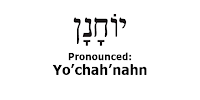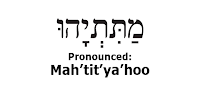The Hebrew Vowels
A E I O U and sometimes Y...To an English speaker, vowels are letters and are no different in form from consonants. In Hebrew, however, the vowels, which specify the sounds of the letters, are composed of dots and dashes and are known as nikkudot (dots).
One may notice, however, that most Hebrew books (and, for that matter, all Torah scrolls) lack nikkudot. Those fluent in Hebrew reading do not need the vowels in order to read the language. However, when one is first learning to read Hebrew, the vowels are very important. We therefore introduce them here:
 The Kamatz looks like a small t but the vertical line is often an attached dot rather than a line. Kamatz gives the consonant a rounded “ah” sound.
The Kamatz looks like a small t but the vertical line is often an attached dot rather than a line. Kamatz gives the consonant a rounded “ah” sound.
 The Patach is a flat, horizontal line and gives the consonant a flat “ah” sound.
The Patach is a flat, horizontal line and gives the consonant a flat “ah” sound.
 The Tzayreh is composed of two dots aligned horizontally. Tzayreh gives the consonant an “ay” sound.
The Tzayreh is composed of two dots aligned horizontally. Tzayreh gives the consonant an “ay” sound.
 The Segol is an upside pyramid of three dots that gives the consonant the sound of “eh.”
The Segol is an upside pyramid of three dots that gives the consonant the sound of “eh.”
 The Sh’va, which is two vertical dots, does not actually create a sound. Rather, the sh’va adopts the natural sound of the letter.
The Sh’va, which is two vertical dots, does not actually create a sound. Rather, the sh’va adopts the natural sound of the letter.
 The Chirik is a single dot directly under the letter that gives the consonant an “ee” sound.
The Chirik is a single dot directly under the letter that gives the consonant an “ee” sound.
 The Cholam creates the sound of “oh” and is either a dot above the letter (slightly to the left) or a vav with a dot balancing overhead.
The Cholam creates the sound of “oh” and is either a dot above the letter (slightly to the left) or a vav with a dot balancing overhead.

 The Koobootz creates an “oo” sound and is represented by a diagonal line of three dots. The same sound is created by the shoorook, which is the letter vav with a dot in its middle.
The Koobootz creates an “oo” sound and is represented by a diagonal line of three dots. The same sound is created by the shoorook, which is the letter vav with a dot in its middle.
One may notice, however, that most Hebrew books (and, for that matter, all Torah scrolls) lack nikkudot. Those fluent in Hebrew reading do not need the vowels in order to read the language. However, when one is first learning to read Hebrew, the vowels are very important. We therefore introduce them here:
 The Kamatz looks like a small t but the vertical line is often an attached dot rather than a line. Kamatz gives the consonant a rounded “ah” sound.
The Kamatz looks like a small t but the vertical line is often an attached dot rather than a line. Kamatz gives the consonant a rounded “ah” sound. The Patach is a flat, horizontal line and gives the consonant a flat “ah” sound.
The Patach is a flat, horizontal line and gives the consonant a flat “ah” sound. The Tzayreh is composed of two dots aligned horizontally. Tzayreh gives the consonant an “ay” sound.
The Tzayreh is composed of two dots aligned horizontally. Tzayreh gives the consonant an “ay” sound. The Segol is an upside pyramid of three dots that gives the consonant the sound of “eh.”
The Segol is an upside pyramid of three dots that gives the consonant the sound of “eh.” The Sh’va, which is two vertical dots, does not actually create a sound. Rather, the sh’va adopts the natural sound of the letter.
The Sh’va, which is two vertical dots, does not actually create a sound. Rather, the sh’va adopts the natural sound of the letter. The Chirik is a single dot directly under the letter that gives the consonant an “ee” sound.
The Chirik is a single dot directly under the letter that gives the consonant an “ee” sound. The Cholam creates the sound of “oh” and is either a dot above the letter (slightly to the left) or a vav with a dot balancing overhead.
The Cholam creates the sound of “oh” and is either a dot above the letter (slightly to the left) or a vav with a dot balancing overhead.
 The Koobootz creates an “oo” sound and is represented by a diagonal line of three dots. The same sound is created by the shoorook, which is the letter vav with a dot in its middle.
The Koobootz creates an “oo” sound and is represented by a diagonal line of three dots. The same sound is created by the shoorook, which is the letter vav with a dot in its middle.

Comments
Post a Comment